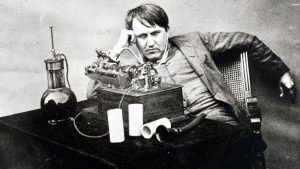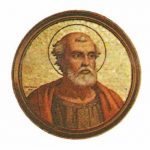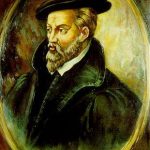History, Holidays & Observances – November 21
A look at some of the history and holidays on November 21
 Holidays & Observances On November 21
Holidays & Observances On November 21
Feast of Pope Saint Gelasius I, a late 5th century Pontiff and the last of North African origin. As the Catholic Encyclopedia writes of him:
Though pope but for four years and a half, he exerted a deep influence on the development of church polity, of the liturgy and ecclesiastical discipline. A large number of his decrees have been incorporated into the Canon Law.
In his private life Gelasius was above all conspicuous for his spirit of prayer, penance, and study. He took great delight in the company of monks, and was a true father to the poor, dying empty-handed as a result of his lavish charity. Dionysius Exiguus in a letter to his friend, the priest Julian (P.L., LXVII, 231), gives a glowing account of Gelasius as he appeared to his contemporaries.
That said, Gelasius is important also to secular history. One, Gelasius advocated the primacy of the Roman Pope over the Eastern Orthodox Church, furthering the schism that would, before long, split apart those two bodies. Two, Gelasius wrote the Famuli vestrae pietatis, a letter laying out the position of the Church that the clerisy had primary power to pronounce on moral and spiritual matters, while Kings had the power to direct on secular matters in the worldly domain. This would be a point of contention between Popes and Kings for over the next millennium.
 Major Events on November 21
Major Events on November 21
1877 – Thomas Edison announced his first truly major invention — the phonograph, a machine that can record and play sound. It would be another ten years before the phonograph became commercially viable.
Edison was a home schooled child with hearing loss from scarlet fever and perhaps an accident. At fifteen he left home and wandered the mid-West during the Civil War, supporting himself as a telegraph operator. Returning home, he eventually made it to New York where he sold one of his earliest inventions, an improved stock ticker, for $40,000. With that wealth, he ceased work as a telegraph operator and began life as a fulltime inventor and businessman. In 1876, Edison moved to Menlo Park, New Jersey, and built his own personal industrial research facility, complete with machine shops and laboratories. It was there that, by accident, he invented the phonograph. It proved to be just one of his many profitable inventions. In 1879 he patented the first successful light bulb and began the first investor owned utility, General Electric Corp. All in all, over his lifetime, this man, with no formal education, was granted over a thousand patents for everything from motion pictures to car batteries. It is safe to say that many of the amenities of modern life got their start in Edison’s workshops.
1905 – Albert Einstein, the father of modern physics, published this day a scholarly article in the journal Annalen der Physik, theorizing that the equivalence of mass and energy is a general principle and a consequence of the symmetries of space and time. In the article, Einstein did not state his formula in the classic terms by which we know it now, but rather explained his theory in a sentence, Indeed, he did not simply the formula to E = mc² until after WWII.
1905 came to be known as Einstein’s “miracle year.” While working as a patent clerk, Einstein published four ground-breaking scientific papers on on the photoelectric effect, Brownian motion, special relativity, and, as noted above, the equivalence of mass and energy, that won him renown — and a doctorate from Zurich University. Enstein continued as a patent clerk for three more years before leaving that job to become a full-time academic in Germany.
1953 – The Natural History Museum, London announces that the “Piltdown Man” skull was a hoax.
The skull was “discovered” in 1912 and, to much fanfare, was thought to answer a missing link in the evolution from ape to man. It became a great controversy in science, with some insisting on its authenticity, while others saw it as problematic. As early as 1923, at least one scientist correctly identified the remains as that of a modern human cranium and an orangutan jaw with filed-down teeth. Still, it was another three decades before the staff of the Natural History Museum came to embrace that conclusion.
The success of the hoax is an example of the potential fallibility of science and the real dangers of confirmation bias. And don’t get me started on the hockey stick and global warming . . .
 Quickies
Quickies
1386 – Tamerlane, the last of the nomadic Mongol conquerers, captures and sacks the Georgian capital of Tbilisi, taking King Bagrat V of Georgia captive during his drive into Russia. Tamerlane adopted the Islamic faith and is largely responsible for utterly destroying the Nestorian Christian Church of the East in much of Asia, imposing Islam by the sword wherever he went. And indeed, he ranged far and wide through large parts of Asia, Africa, and Europe. “Scholars estimate that his military campaigns caused the deaths of 17 million people, amounting to about 5% of the world population at the time ”
1920 – Irish War of Independence: In Dublin, 31 people are killed in what became known as “Bloody Sunday“.
1970 – Vietnam War: A joint United States Air Force and Army team raids the Sơn Tây prisoner-of-war camp in an attempt to free American prisoners of war thought to be held there.
1985 – United States Navy intelligence analyst Jonathan Pollard is arrested for spying after being caught giving Israel classified information on Arab nations. He is subsequently sentenced to life in prison.
2017 – Robert Mugabe formally resigns as President of Zimbabwe, after thirty-seven years in office.
 Born on November 21
Born on November 21
1694 – Voltaire, the last, and perhaps the only, great liberal philosopher to come out of France. The rest have all been disasters for Western civilization, from Rousseau’s philosophical foundation for socialism to Foucalt’s post-modernism.
1760 – Joseph Plumb Martin, served as an enlisted soldier through the entire American Revolution. He joined the militia at age 15 and fought in the first battles at Lexington and Concord, then served as a Continental soldier under Washington’s command, from the 1776 disasters in New York to the (near) final victory a the 1781 siege at Yorktown. Then he wrote a memoir. There are a paucity of first hand accounts of the Revolutionary War told from the perspective of the common soldier. That makes Joseph Plumb Martin’s memoirs of his time in service invaluable.
On a personal note, the book is a fascinating read. An infantry soldier’s life in the field during any sort of extended deployment is always one of hardship, not just from warfare itself, but from a life exposed to the elements, sometimes hunger, and at least during the Revolution, disease as well. Thus it is not surprising at all that Martin recorded in detail virtually every satisfying meal he ate (few and far between) and every moment of creature comfort he experienced to relieve him of the wet and cold. Indeed, for all the world has changed, an infantryman of today reading Martin’s memoirs would likely see a kindred spirit.
 Died on November 21
Died on November 21
1555 – Georgius Agricola was a German scholar, mineralogist and metallurgist referred to today as the Father of geology. His twelve volume work, De re metallica libri XII, published posthumously, was the definitive guide to finding, mining and smelting ore for the next two centuries. It was last translated into English for publication in 1912 by an American mining engineer, Herbert Hoover. You might recognize that name.




